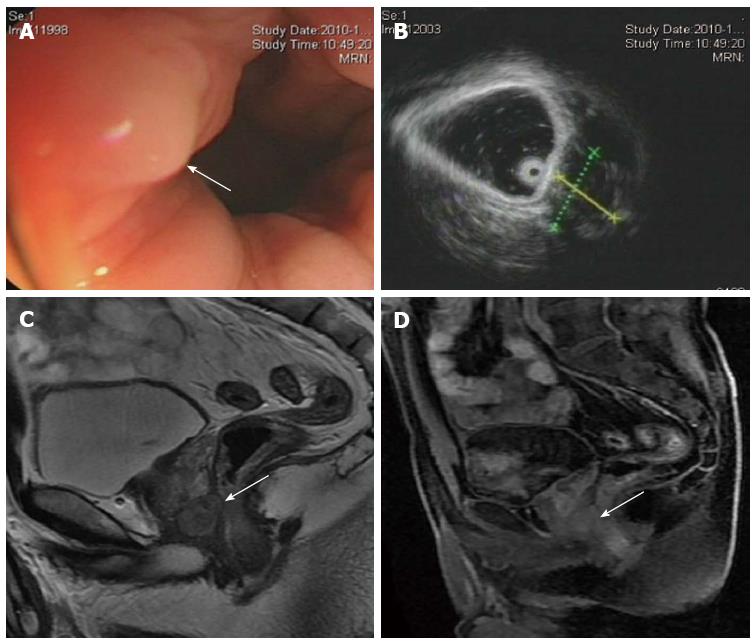Copyright
©2013 Baishideng Publishing Group Co.
World J Gastroenterol. May 28, 2013; 19(20): 3108-3116
Published online May 28, 2013. doi: 10.3748/wjg.v19.i20.3108
Published online May 28, 2013. doi: 10.3748/wjg.v19.i20.3108
Figure 1 A 40-year-old man with a rectal gastrointestinal stromal tumor.
A: Colonoscopy shows a mass protruding from the rectal wall with intact overlying mucosa (arrow); B: Endoscopic ultrasonography shows a well-defined hypoechoic mass located along the right anterior aspect of the rectal wall; C: Sagittal T2-weighted magnetic resonance imaging shows an oval, homogenous, hyperintense mass with a sharp margin bordering the anterior rectal wall. A small area of anatomical continuity between the tumor and the anterior rectal wall is observed (arrow); D: Postcontrast T1-weighted image shows a slightly homogenously enhancing mass (arrow).
Figure 2 A 56-year-old man with a rectal gastrointestinal stromal tumor.
A: Axial T1WI shows the lesion as a round, intraluminal, homogenous, hypointense mass with a sharp margin (arrow); B: It shows homogenous hyperintense on T2WI (arrow); C: Sagittal enhanced T1WI shows homogenous moderate enhancement (arrow); D: Photomicrograph shows fascicular proliferation of spindle-shaped tumor cells (hematoxylin and eosin, × 200); E: The tumor cells were strongly and diffusely positive for CD117 staining (immune-histochemistry, × 200).
Figure 3 A 62-year-old man with a rectal gastrointestinal stromal tumor.
A: The mass is located between the prostate and the anterior rectal wall and its epicenter is well outside the rectum. Axial T1-weighted MR image shows a high signal (arrow) within the mass, in keeping with hemorrhage; B: Sagittal T2WI shows a heterogenous mixed-intense mass with blurring contour (arrow); C: Postcontrast T1WI shows the solid component of the mass enhanced heterogeneously (arrow); D: Macroscopic cross section shows a pale yellow, tan and solid mass with hemorrhage (arrow).
Figure 4 A 52-year-old man with a rectal gastrointestinal stromal tumor.
The mass is located in the left posterior wall of the rectum with scattered calcification (arrow).
Figure 5 A 61-year-old man with a rectal gastrointestinal stromal tumor.
A: The mass located in the left wall of the rectum with fleck of calcification at the tumor margin (arrow); B: The mass enhanced heterogeneously following intravenous administration of contrast media.
Figure 6 A 53-year-old man with a rectal gastrointestinal stromal tumor.
A: Computed tomography scan shows a round intraluminal mass with a sharp margin; B: Photomicrograph shows the tumor originating from the muscularis propria (arrow) of the rectum (hematoxylin and eosin, × 20).
Figure 7 A 59-year-old woman with a rectal gastrointestinal stromal tumor.
The mass is located between the uterus and the anterior rectal wall with focal fluid signal on T2WI corresponding to necrosis (arrow).
Figure 8 A 31-year-old man with a rectal gastrointestinal stromal tumor.
A: Axial T2WI shows the lesion as an intraluminal mass with ulceration (arrow) of the rectal lumen; B: The mass is enhanced moderately heterogeneously following intravenous administration of gadolinium.
- Citation: Jiang ZX, Zhang SJ, Peng WJ, Yu BH. Rectal gastrointestinal stromal tumors: Imaging features with clinical and pathological correlation. World J Gastroenterol 2013; 19(20): 3108-3116
- URL: https://www.wjgnet.com/1007-9327/full/v19/i20/3108.htm
- DOI: https://dx.doi.org/10.3748/wjg.v19.i20.3108




















